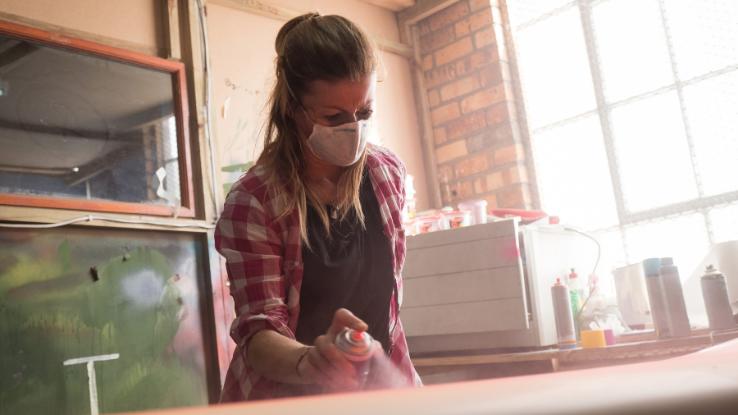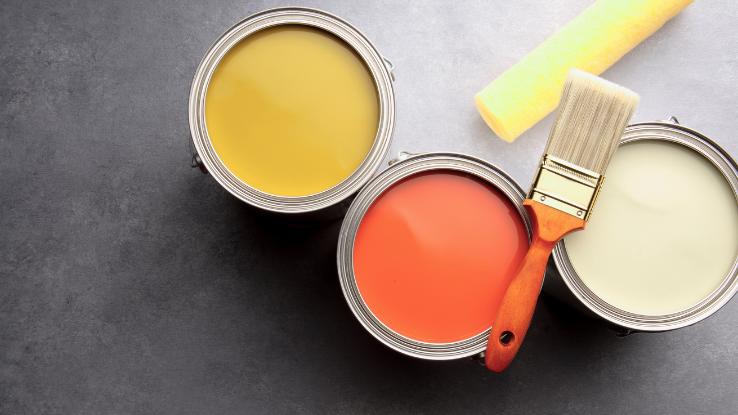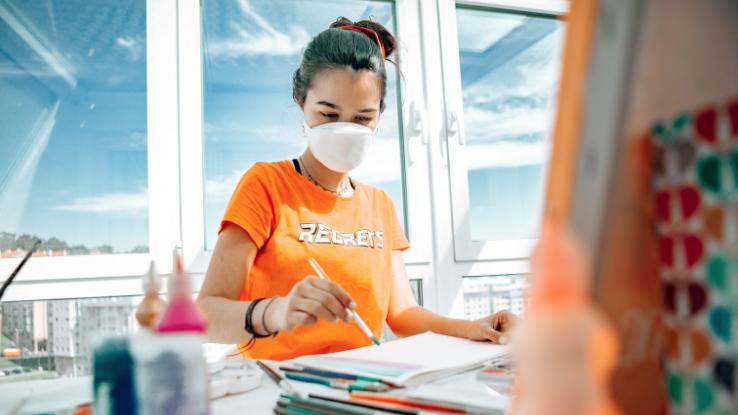Can You Paint Over Acrylic Paint

Without a doubtfulness, indoor painting is a common home improvement project. After all, in that location's no easier manner to completely transform a space. However, that splash of color may non be completely take a chance-gratuitous. That is, with proper ventilation, and in the right weather, painting can exist a perfectly condom activity, simply if y'all aren't conscientious — or if you're working in an environs with poor ventilation — the use of paints that give off unsafe fumes can lead to harmful health effects.
Types of Pigment
Latex:

Latex pigment is commonly used for indoor projects because it tin can exist hands cleaned and dries relatively quickly. However, it can cause stomach discomfort or vomiting if ingested, even though it is not poisonous.
Oil-based:
Oil-based paints are irritating to the skin. If ingested, oil-based paints pose a greater risk than latex paints. If oil-based pigment is aspirated (inhaled) during choking, it tin pb to pneumonia in the lungs.
Solvent-based:
Solvent-based paints tin cause skin irritation besides. Additionally, they give off fumes that, when inhaled, can pb to dangerous symptoms.
What Makes Paint Fumes Dangerous?
VOCs, or volatile organic compounds, are a byproduct of either solids, liquids or a combination of both in pigment. When paint is applied, the byproduct is released into the atmosphere in the form of a gas (paint fumes). VOCs are more often than not present at a college concentration when painting indoors — in fact, equally much equally x times higher than when painting outdoors.

The term VOC refers to a variety of different chemicals, many of which can have a negative effect on a person's health. In addition to paints, VOCs can likewise be found in many other products, including:
- Lacquers
- Varnishes
- Cleaning products
- Pesticides
- Part printers
- Carbonless copy paper
- Glues
- Adhesives
- Permanent markers
- Photocopiers
- Fuels
- Cosmetics
- Crafting materials
Negative Wellness Effects Caused By the VOCs in Paint Fumes
There is a wide diverseness of both brusk-term and long-term negative wellness effects associated with VOCs in paint fumes. The severity of the wellness effect depends on several different factors, including both the length of time and the level of exposure. Some examples of short-term, temporary side furnishings include:

- Irritation of the eyes, nose, throat or and/or respiratory tract
- Visual disturbance
- Headache
- Loss of coordination
- Nausea
- Lightheadedness
- Dizziness
- Allergic skin reaction
- Fatigue
- Memory impairment
Some of the conditions above can go chronic in individuals who are regularly exposed to VOCs in paint fumes either in the habitation or at work. Long-term wellness effects of VOCs may include:
- Liver damage
- Kidney impairment
- Central nervous organisation impairment
- Certain types of cancer
- Asthma
How Long Do VOCs Last?
The odor emitted from freshly stale pigment is a outcome of the ingredients within the paint that brand it a liquid substance. These substances evaporate into the air while the wet paint is drying. The wetter the paint, the more substances are released into the air and the stronger the odour. As the liquid portion of the pigment continues to evaporate, odorous paint fumes continue to form. As evaporation proceeds, the process of dispersion also occurs.

Dispersion occurs when the fumes mix with the air and are dispersed into the environment. Equally dispersion occurs, more and more of the fumes are carried throughout the air, which makes them less full-bodied, and the odor less strong. When the paint is stale entirely and the fumes are completely dispersed, the aroma somewhen disappears. Remember: VOCs are at their highest concentration when pigment is freshly wet.
Paint Fumes and Pregnancy
Many healthcare professionals recommend that significant people avert exposure to paint so as to avoid potential fumes. Exposure to VOCs in paint is believed to be associated with an increased hazard of miscarriage. Additionally, babies and immature children should non be exposed to wet pigment as they are more than susceptible to damage from its effects.

How to Protect Yourself
When painting or using other substances that may contain VOCs, it is recommended that ane use appropriate personal protective equipment (PPE). This includes gloves, which helps one avoid straight contact with paint, and a mask that contains a filter, which reduces the number of harmful particles 1 is inhaling.

In addition, use of these substances is not recommended in enclosed spaces, where at that place is inadequate ventilation. Try to paint outdoors when possible. If you call up you accept been exposed to pigment fumes and are feeling any of the same symptoms, it is important to contact your healthcare provider immediately.
Resource Links:
- National Upper-case letter Poison Command
- Science Direct
- Usa Environmental Protection Agency (EPA)
Source: https://www.symptomfind.com/health/paint-fumes-dangerous?utm_content=params%3Ao%3D740013%26ad%3DdirN%26qo%3DserpIndex
Posted by: englandrestroulner.blogspot.com


0 Response to "Can You Paint Over Acrylic Paint"
Post a Comment